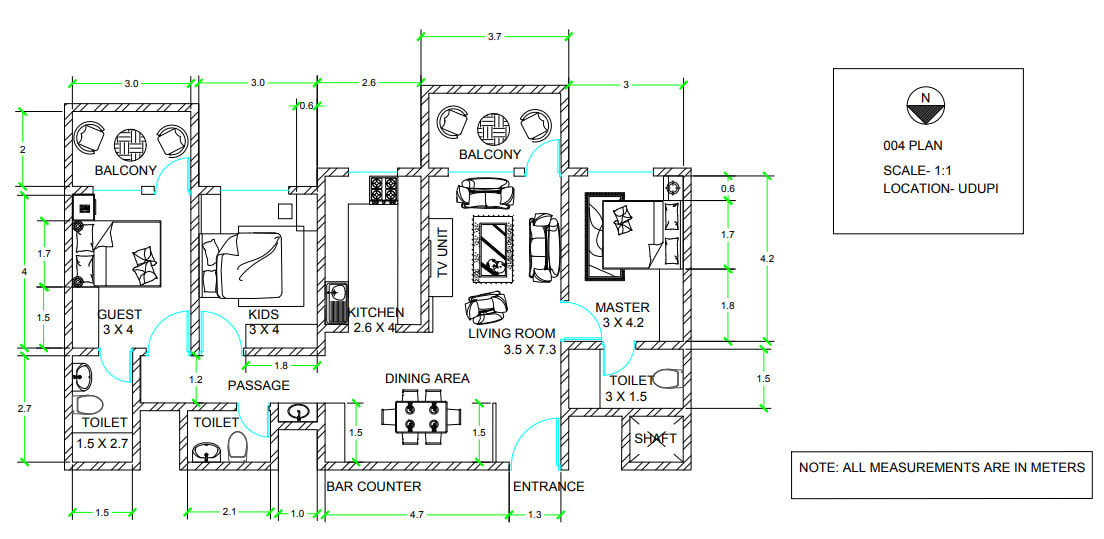
I don't do any work in 2D anymore except for producing 2d documents.
POCHE FLOOR PLAN WALLS IN AUTOCAD FOR MAC PDF
If you want examples of my CDs in PDF I can upload. Then if they enable smart scrapbook objects, I'm ready to switch. Of course Visio has a somewhat different interaction environment than Sketchup, but then again so does Layout.Įventually I hope Trimble integrates the entire Sketchup/Layout system into one program with two modes: 2D and 3D. Again Visio's smart shapes beat Layout hands down. (Nothing ever has to be "exploded" to proceed further so smarts are never lost.)ģD Design: Once I develop a few preliminary plan schemes in 2D: then I export to Sketchup to begin the process you all use.Ĭonstruction Drawings: When my client chooses a design scheme, then I start CDs as I described at the top. It also has multiple object alignment tools, equal spacing tools and polygon Boolean tools still missing from Layout. I can poche walls to correspond to various types (new, existing, demolished). When I'm ready, Visio has dynamic self joining wall objects and an overall grid environment that makes 2D design and iteration very quick. Visio has smart room labels showing overall room dimensions like real estate plans like to show and clients can read. At this stage I want to manipulate 2D spaces (rooms) not walls. Preliminary Floor plans: Visio is excellent for 2D design iteration and layout of SPACES. I can insert a live referenced and properly formatted excel object to show allowable coverage calculations. I start with the survey which I can input using smart boundary dimensions (bearing, arc length and angle, and closing bearing) then add zoning setbacks (smart offset dimension lines straight and curved, dimension drop from point perpendicular to property line) and smart area labels for overall site area and footprints of existing and proposed structures and decks. Preliminary Site Design: Zoning limits are always crucial for my work. Visio has dozens of indispensable smart notational objects and an easy way of making your own. I'm no fan of parametrics for most physical objects, but for notational objects, Layout is limited to standard dimensions. The main problem with Layout is that scrapbook objects are dumb. I looked at Layout at each release to replace Visio but believe it has a long way to catch up for both preliminary design AND construction drawings. (exporting jpegs from Sketchup and importing to Visio for elevations and sections, and section cuts for section drawings to Visio, then adding dimensions, masks, grade lines, notations etc.) The Layout approach involves less redundancy because the 3D model is referenced dynamically but unfortunately the section cuts cannot be. Long before Layout existed I evolved a workflow for construction documents very similar to Sonder's but using Visio instead of Layout for 2D.

At the time Sketchup was called ("Visio on steroids"). Then I jumped on Sketchup in Beta in 2000 and adopted it for 3D. I found it much better than AutoCad especially for plan design and also for CDs. Mid 90's I adopted Shapeware's Visio (in beta and long before Microsoft bought it) for 2D. (except on site to record existing conditions for a reno.) (see for examples of 3D and 2D DESIGN drawings.) I never use a pencil. I do all my own drawings including structural and electrical.

See below for why it's not yet worth it to me.īackground: I'm a sole proprietor (like Nick Sonder) doing houses, additions and renovations.

It's great to see what you folks are doing, but overall I'm not ready to jump to Layout for anything. I stumbled upon the 6 Sonder videos, then this forum, which inspired me to share my experiences. How do I raster render one and vector render the other when they are both coming into Layout simultaneous? Once I have Inserted the Scene, am I able to edit it (in Layout) by selecting a specific group as one does in SU itself? I hope I am not missing something but this is the first time I am using Layout fror CD's. I have one scene (consisting of 2 groups) and one Insertion. My understanding is that he then Inserts the "Model Group" and then as a second Insertion he inserts the "Linework Group" into Layout? My setup is different: I am not using a referenced "Parent - Child" x-ref arrangement. Now I am led to believe according to this discussion that once Inserted into Layout, the Model itself should be Raster rendered and the Linework should be Vector rendered? According to Nick's procedure he uses a separate SU model referenced to his Master Base Model, which contains only Linework. To clarify: the Linework Group is outside of the Model Group. The scene consists of two groups (as shown in Outliner), the model group itself and the linework group that has been created with "Create group from slice" and 'faced' ala Nick Sonder's videos. This happens to be a Plan Section but my question would apply to all Section Cuts.

I am inserting a scene from SU into Layout.


 0 kommentar(er)
0 kommentar(er)
